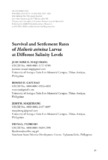Optimum low salinity to reduce cannibalism and improve survival of the larvae of freshwater African catfish Clarias gariepinus
- Global styles
- MLA
- Vancouver
- Elsevier - Harvard
- APA
- Help

View/
Date
2017Author
Page views
5,220ASFA keyword
AGROVOC keyword
Metadata
Show full item record
Share
Abstract
The freshwater African catfish Clarias gariepinus is carnivorous and cannibalistic even during the larval and juvenile stages and this behavior causes economic losses in aquaculture. This study examined for the first time the effect of salinity on cannibalism, survival, and growth of African catfish larvae in the hatchery. Larvae (4 days old, median 7.8 mm TL, 2.8 mg BW) of the African catfish were reared for 21 days at nominal salinity 0, 1, 2, 3, 4, 5, 6, and 7 ppt. After 21 days, they grew to 10–39 mm (median 22 mm) and 10–490 mg (median 90 mg), with no significant difference by salinity treatments. Survival ratios were similarly low (24–31%) at 0, 1, 3, and 7 ppt and significantly higher (49–55%) at 2, 4, 5, and 6 ppt. Cannibalism was significantly lower, 15–30% at 4–6 ppt, than the 40–50% at 0–3 and 7 ppt. Size variation was lower at 4–6 ppt and higher at 0–3 and 7 ppt. We recommend hatchery rearing of African catfish at the optimum low salinity of 4–6 ppt rather than in full fresh water at least up to 21 days. This rearing method fosters larval welfare and improves hatchery production.
Suggested Citation
Kawamura, G., Bagarinao, T., Yong, A. S. K., Sao, P. W., Lim, L. S., & Senoo, S. (2017). Optimum low salinity to reduce cannibalism and improve survival of the larvae of freshwater African catfish Clarias gariepinus. Fisheries Science , 83(4), 597-605. https://doi.org/10.1007/s12562-017-1088-y
Type
ArticleISSN
0919-9268; 1444-2906Collections
- Journal Articles [1258]
Related items
Showing items related by title, author, creator and subject.
-
Survival and settlement rates of Haliotis asinina larvae at different salinity levels
Maquirang, Jean Rose H.; Caturao, Romeo D.; Maquirang, Jessy H.; Pedroso, Fiona L. (IAMURE Multidisciplinary Research, 2013)The study was conducted to determine the optimum salinity levels (24 ppt, 28 ppt, 32 ppt, 36 ppt and 40 ppt) for the survival and settlement rates of H. asinina in a complete randomized design with three replicates each. ... -
Growth response of Nile tilapia fry to salinity stress in the presence of an ‘internal reference’ fish
Basiao, Zubaida U.; Eguia, Ruel V.; Doyle, Roger W. (Blackwell Publishing, 2005)Growth of three strains of Oreochromis niloticus L. fry exposed to salinity stress in the presence of an internal reference fish were compared. The Central Luzon State University (CLSU) strain was obtained from the Freshwater ... -
Enrichment of live food with essential fatty acids and vitamin C: effects on milkfish (Chanos chanos) larval performance
Gapasin, R. S. J.; Bombeo, R.; Lavens, P.; Sorgeloos, P.; Nelis, H. (Elsevier, 1998)The effects of essential fatty acids (EFA) and vitamin C-enriched live food on growth, survival, resistance to salinity stress and incidence of deformity in milkfish larvae reared in tanks were investigated. Larvae were ...





